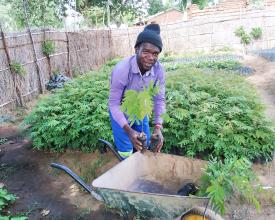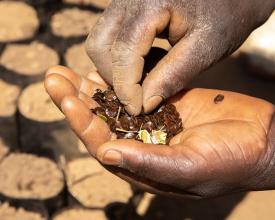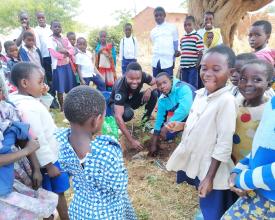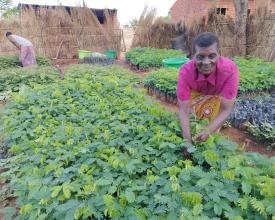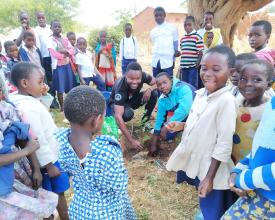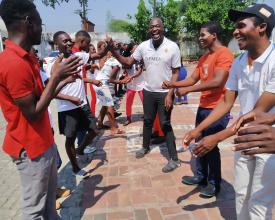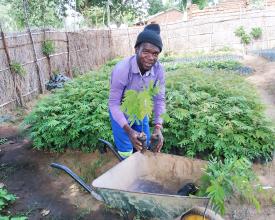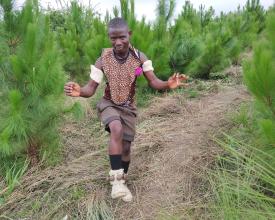
Restauration de la forêt et des terres de Chuma Chathu axée sur les enfants dans les montagnes de Kirk Range
L'agriculture, activité économique majeure représentant 91 % des revenus, est la principale utilisation des terres dans le district de Ntcheu, qui est essentiellement rural. Malgré cela, 97 % des agriculteurs pratiquent une agriculture de subsistance avec une superficie moyenne d'un hectare par ménage. Le district est confronté à une déforestation rampante et à une dégradation de l'environnement qui menacent l'équilibre écologique et le bien-être de ses habitants. La disparition du couvert forestier entraîne l'érosion des sols, la diminution de la qualité de l'eau et la perte de biodiversité, ce qui aggrave la pauvreté et l'insécurité alimentaire.
Pour relever ces défis, des programmes d'éducation à l'environnement ont été mis en place dans les écoles des Kirk Range Mountains. Ces programmes comprennent la création de boisés et de vergers et la promotion d'une agriculture intelligente sur le plan climatique dans les jardins scolaires et au sein de la communauté. Les jeunes jouent un rôle clé dans la sensibilisation, tandis que les membres de la communauté reçoivent une formation complète sur les pratiques forestières durables, les techniques d'agroforesterie et la conservation de la biodiversité.
Contexte
Défis à relever
L'agriculture est considérée comme une activité économique majeure, représentant 91 % des revenus, bien qu'elle soit pratiquée à très petite échelle, suivie par le petit commerce (10 %). 97 % des agriculteurs pratiquent une agriculture de subsistance avec une superficie moyenne de 1 ha par ménage et dépendent fortement de cette activité pour leurs revenus. La perte de la couverture forestière contribue à l'érosion des sols, à la diminution de la qualité de l'eau et à la perte de biodiversité, ce qui exacerbe la pauvreté et l'insécurité alimentaire.
Emplacement
Traiter
Résumé du processus
L'élaboration et la mise en œuvre d'un programme axé sur les personnes, grâce à la gestion communautaire, à l'engagement des jeunes et à la sensibilisation, sont essentielles pour l'appropriation et la durabilité du programme. La sensibilisation aux problèmes environnementaux auxquels la communauté est confrontée et les solutions possibles convenues, défendues par les jeunes, garantissent que la communauté joue un rôle de premier plan dans la gestion du programme.
Blocs de construction
Bloc 1 - Gestion de la communauté
Le programme est piloté par la communauté, ce qui signifie que les jeunes dans les écoles et les clubs de jeunes, ainsi que les membres de la communauté, en particulier les femmes dans les comités de gestion des ressources naturelles, sont à la fois les participants et les bénéficiaires des efforts de restauration. Le programme bénéficie d'un grand soutien de la part des chefs traditionnels. La communauté décide où la restauration doit être effectuée, comment et quand elle doit l'être. Cette approche garantit l'appropriation par la communauté et la durabilité du programme.
Facteurs favorables
La communauté doit diriger le processus et jouer un rôle clé dans les activités tout au long du programme.
Le fait de s'engager très tôt auprès des chefs traditionnels de la communauté permet d'obtenir leur adhésion et a permis aux clubs de jeunes d'être couronnés de succès. Par exemple, les chefs traditionnels ont attribué des parcelles de terrain dans les montagnes aux jeunes de la communauté, afin qu'ils les protègent et les gèrent.
La participation active des femmes a permis la mise en place effective de pépinières que les femmes de la communauté gèrent et entretiennent, ce qui leur a permis d'appliquer concrètement leurs connaissances en matière de régénération naturelle et d'agroforesterie, et d'utiliser ces pratiques sur leurs propres terres.
L'implication directe des écoles de la région locale a permis d'accéder aux jeunes, et nous avons pu les aider à cultiver et à gérer des pépinières et des boisés.
Leçon apprise
Les connaissances et la participation locales sont cruciales. Elles apportent un sentiment d'appropriation, les communautés se sentent partie prenante de la solution et s'investissent davantage dans sa réussite, ce qui rend l'impact du programme plus durable.
Élément de base 2- L'engagement des jeunes en tant que futurs champions de la restauration
Les jeunes, qui constituent environ la moitié de la population du Malawi, se mobilisent et se regroupent dans des clubs de jeunes. Ils prévoient de s'attaquer aux problèmes environnementaux qui les affectent directement et indirectement dans leurs communautés. Il s'agit d'une catégorie de personnes énergiques et innovantes qui s'attachent à façonner un avenir meilleur en sensibilisant la communauté par le biais d'arts tels que le théâtre, la musique, les poèmes et les réunions communautaires. Ils travaillent en étroite collaboration avec les chefs traditionnels qui les soutiennent en leur donnant accès à des terres à restaurer, en convoquant les membres de la communauté à des réunions communautaires et en faisant respecter les normes communautaires.
Facteurs favorables
La moitié des 17,6 millions d'habitants du Malawi, qui sont des jeunes âgés de 10 à 35 ans, devraient être organisés en clubs de jeunes pour participer activement au programme. Les clubs de jeunes doivent identifier les forêts et les terres dégradées qui doivent être restaurées en collaboration avec les chefs traditionnels. Les jeunes élèveront des semis d'arbres, les planteront et en prendront soin en les protégeant des feux de brousse, de l'empiètement et de la coupe abusive. Les jeunes de l'école apprennent les techniques de restauration et les mettent en pratique au sein de l'école avec le soutien des autorités scolaires.
Leçon apprise
Le fait de comprendre les énormes avantages futurs de la restauration des forêts et des terres motive les jeunes à participer activement au programme et à se l'approprier. Par exemple, outre la régénération naturelle, le Chibwana Youth Club prévoit de planter plus de 4 000 pins chaque année dans les Kirk Range Mountains, ce qui leur permettra, une fois vendus, de construire des bâtiments scolaires, leur fournira un capital pour lancer de petites entreprises et paiera les frais de scolarité des élèves nécessiteux. Les jeunes ont donc le sentiment d'être non seulement des participants au programme, mais aussi des bénéficiaires.
Élément de base 3 - La sensibilisation, un outil de changement
Afin d'obtenir un changement de comportement au sein des communautés, des messages bien conçus sur la restauration de l'environnement et l'agriculture intelligente face au climat doivent être diffusés d'une manière persuasive, passionnante et attrayante qui soit conviviale pour tous et culturellement acceptée par les communautés concernées. Des exemples pratiques bien connus sont présentés pour faciliter la compréhension du programme.
Facteurs favorables
Les jeunes utiliseront de manière innovante leurs talents et les ressources excitantes disponibles pour atteindre leur public, à savoir la communauté, avec des messages sur l'agriculture intelligente face au climat, la restauration des forêts et des terres, les impacts négatifs de la dégradation des terres et des forêts et la manière dont ils peuvent collectivement s'attaquer au problème.
Leçon apprise
L'utilisation de médias virtuels tels que des vidéos sur la restauration des forêts et des terres sur grand écran (projecteur) et l'utilisation d'arts tels que le théâtre et la musique attirent un grand nombre de membres de la communauté qui écoutent avec enthousiasme les messages qui sont transmis.
Impacts
La biodiversité s'est considérablement accrue grâce au boisement, à la régénération naturelle et à l'agroforesterie.
Amélioration de la sécurité alimentaire des ménages chez 366 agriculteurs suiveurs et 135 agriculteurs principaux qui ont été formés à diverses technologies agricoles intelligentes sur le plan climatique.
Réduction de l'érosion des sols grâce à l'amélioration et à la restauration du couvert forestier.
Amélioration des connaissances et des compétences en matière de restauration des forêts et des terres et d'agriculture intelligente face au climat grâce à la formation et à la sensibilisation à la biodiversité.
En outre, le programme renforce la cohésion et la collaboration au sein des communautés.
Bénéficiaires
Les femmes et les jeunes des communautés touchées, ainsi que les enfants des écoles, ont participé au programme et ont apprécié l'amélioration de la sécurité alimentaire, l'acquisition de nouvelles connaissances et compétences, la réduction du ruissellement, l'embellissement du paysage et l'accès facile au bois de chauffage.
Objectifs de développement durable
Histoire
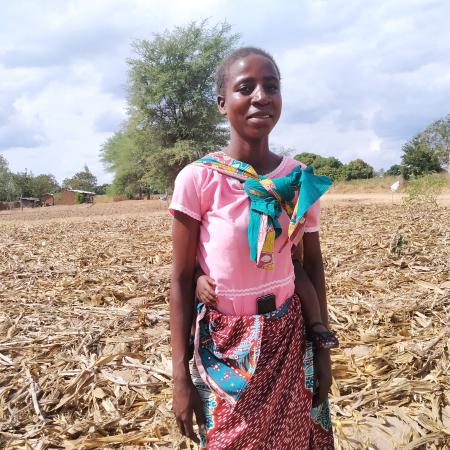
Voici Elizabeth Banda du village de Kukhola II dans l'autorité traditionnelle de Makwangwala dans le district de Ntcheu, au Malawi. Eliza a 30 ans et trois enfants. Eliza fait partie des agriculteurs qui ont adopté les technologies agricoles intelligentes face au climat et les ont appliquées dans leurs propres champs à partir des parcelles de démonstration. Sur la même terre où Eliza et son mari récoltaient 75 kg de maïs avant l'adoption des technologies agricoles intelligentes face au climat, ils récoltent maintenant 500 kg de maïs après l'adoption et la mise en pratique des technologies agricoles intelligentes face au climat. "J'ai travaillé avec très peu de rendement pendant de nombreuses années, mais maintenant je reçois la meilleure récompense de mon travail dans le jardin grâce à l'agriculture intelligente face au climat. Dans son jardin, Eliza applique du compost et du fumier animal, construit des Swalleys pour récupérer l'eau de pluie la plus rare et réduire le ruissellement, pratique la plantation en fosse, l'agroforesterie et le paillage.
